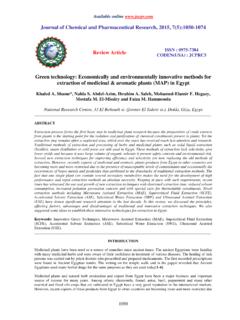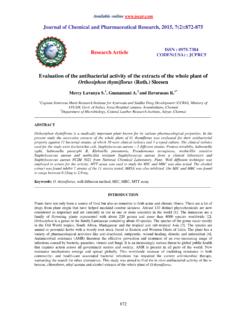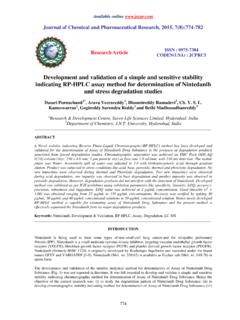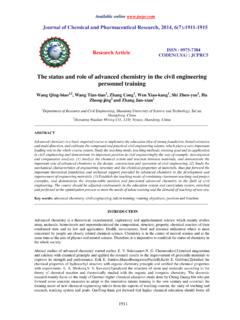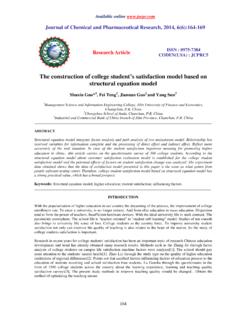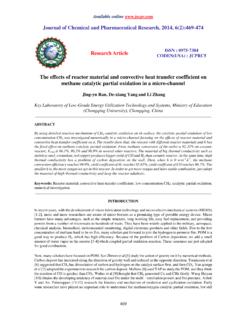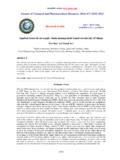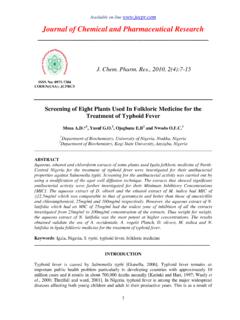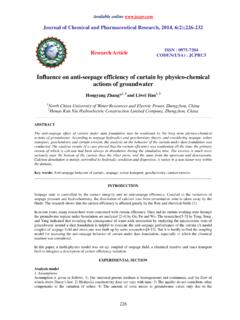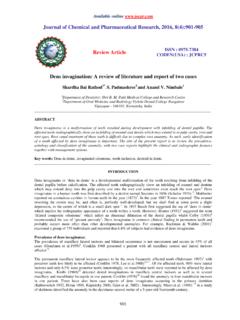Transcription of Montan wax: The state-of-the-art review
1 Available online Journal of Chemical and Pharmaceutical Research, 2014, 6(6):1230-1236 Research article issn : 0975 - 7384 coden (USA) : JCPRC5 1230 Montan wax: The state-of-the-art review Xi Wei1, Cheng Yuan1, Huifen Zhang2 and Baocai Li1* 1 Faculty of Life Science and Technology, Kunming University of Science and Technology, Kunming, China 2 Food Security Research Institute of Yunnan Province, Kunming University of Science and Technology, Kunming, China _____ ABSTRACT Montan wax origins from ancient plant which leads a long and slow way towards becoming lignite thousands of years ago, their composition is very complex. Crude Montan wax is obtained after organic solvent extraction from lignite, then deresined wax is acquired by cooling the extracted solvent toluene, last refined wax called S wax could be made after a series oxidation process, which can be used as basic raw materials for production of more valuable synthetic wax.
2 Montan wax have a wide range of applications in industry in agriculture, and in forestry. But there are still some problems,for instance, crude Montan wax has dark colour, which restricted its application; plenty of by-product resin increase the production cost. Given the Montan wax`s wide range application value and the crucial role in the national economy, we should strengthen the study of Montan wax and find the way to comprehensive utilization. The author has systematically summarized the research progress of the Montan wax and analyzed the deficiencies and problems in china,in order to speed up the Montan wax research process. Key words: Montan wax; fundamental research; production; application progress. _____ INTRODUCTION Montan wax is natural wax obtained from lignites, which contains pure wax (50-80%), resin (20-40%) and bitumen (10-20%). Due to its good physical and chemical properties, Montan wax is often an ideal substitute for the expensive Carnauba Wax.
3 It is widely used in daily chemical industry, wax polish industry, carbon paper industry, electrical industry, machinery industry and many other industries using wax. Germans were the first to extract Montan wax from lignite in 1897. The United States, Ukraine, the Czech Republic have had established Montan wax industry successively in 1905[1]. Wolfmeier et al. [2] have reported that the annual market demand for Montan wax has reached 25,000 tons in 2005. But, Montan wax industry starts relatively late and is characterized by weak foundation and backward research in china. The domestic heyday of the research on Montan wax was during 1980s~1990s. Since the 20th century , very few people were involved in the research about Montan wax and only a few reports were made about it. Fundamental research of Montan wax Montan wax is brown-black solid, non-toxic, tasteless, high melting point.
4 It has good gloss and chemical stability, can be dissolved in many kinds of organic solvent,and be easily saponification and emulsified. The main index to evaluate the quality of Montan wax are melting point, acid value, easter value, saponification value. Baocai Li et al J. Chem. Pharm. Res., 2014, 6(6):1230-1236 _____ 1231 Table 1 Quality index table of the main domestic Montan wax oringin Origin Sample Melting point ( C) Acid value (mg KOH/g) Easter value (mg KOH/g) Saponification value (mg KOH/g) Colour Yunnan Yuxi Crude wax 48 32 80 Dark brown Deresined wax 49 49 98 Light brown Refined wax 139 49 188 Creamy white Yunnan Xundian Crude wax 44 43 87 Dark brown Deresined wax 47 49 96 Light brown Refined wax 106 52 158 Light yellow Yunnan Zhaotong Crude wax 42 44 86 Dark brown Deresined wax 43 52 95 Light brown Refined wax 125 15 140 Creamy white Heilong- jaing Shuangyashan Crude wax 31 35 65 Dark brown Deresined wax 31 37 68 Light brown Refined wax 59 105 164 Creamy white Montan wax consist of three separated parts.
5 Long chain wax alcohols, long chain wax acids and wax esters formed by them, the carbon number of which is in the range of Li[3]used an anion exchange chromatogram column and a silica gel column to divide the de-resination Montan wax and its oxidized wax into four parts: the free acid, ester acids, alcohols, hydrocarbons, and proved that the method had ideal performance of the separation by the infrared spectrum. Baocai Li et al[4] continued to use methods such as GC-MS to analyze the structure of Montan wax produced in Xundian and Shulan, the results showed that the literature of the past which regarded Montan wax made from n-alkanes, normal alkane alcohols,was not accurate[5-6]. In fact, Montan waxes extracted from different lignite differ greatly in their constituents and content. For example, free acid contained in waxes produced in Shulan mainly comprises of normal monobasic alkane acid, while free acid contained in waxes produced in Xundian contains a lot of substances not the normal monobasic alkane acid[7] ,but some alkane component is the minimum part in the Montan wax, and the content of other three parts varies widely depending on different sources.
6 Some researchers[8] were found that the aliphatic constituents of wax are C14-C42 n-alkanes with high coefficients of oddness, C14-C30 saturated alcohols, C14-C36 higher fatty acids and ester. The contribution of unsaturated compounds was found. The structure and formation conditions of coal are considered. In 2008, Noskova[9]analyzed the alkaline hydrolysis products of Montan wax with chromatograph, IR and NMR, the study showed that de-resination wax could be divided into four parts: hydrocarbons, alcohols, acids and unsaponifiable esters, which was in accord with Baocai Li trial papers in the 1990s[3]. The production of Montan wax Pre-treatment of raw materials China has the lignite of relatively high moisture content with an average of about 30%[10]. It s not conducive for transportation, causes extra cost and influences its economic efficiency. In the view of the characteristics of domestic high moisture lignite, drying before utilization seems particularly important.
7 Domestic literatures showed that lignites before being dried was studied as a type of energy fuel used in combustion, pyrolysis and gasification. However, as a type of physical resource for Montan wax extraction, there are scarcely any studies about its treatment. Researchers at abroad show that[11], compared with other factors, the water content has the greatest impact on the amount and rate of extraction in lignite. Even if the lignite is dried to a constant weight, when it is rewetted to contain 20% moisture content, we can still obtain the extraction content, which is the same with that of 20% moisture content lignites. When the moisture is in the range of 10% -20%, it reaches the maximum extraction rate, then it tends to be stable. If drying almost completely, about 1% moisture content, the extraction efficiency of lignites is the minimum.
8 This phenomenon might be explained by two reasons: first, the lignite contains so many hydroxyl, carbonyl, carboxyl and carbon-hydrogen bonds[12] on its surface which causes lignite to form hydrogen bonds and Van Der Waal s Force (VDW) with the residual water on its surface. Second, the lignite will shrink distinctly when the water content is excessively low, which results in inadequate pore diameter and low rate of diffusion. When the Montan wax`s extraction time is about 180 minutes, it gets the maximum amount of extraction. The drying temperature of lignite has almost no impact on the extraction of Montan wax. Therefore, the drying temperature can be increased to reduce the drying time. However, the temperature can not exceed 135 C, which will cause lignite to spontaneously combust. The data shows under the presence of oxygen, the linolenate oxidation[13] occurs at 105 C and above, considering the drying process may cause the wax`s oxidation, the drying temperature is better to be controlled at below 105 C.
9 Baocai Li et al J. Chem. Pharm. Res., 2014, 6(6):1230-1236 _____ 1232 Crushed lignite particle size has little impact on the Montan wax extraction process. Its size is generally required at between and [14]. Larger particle size will reduce the extraction efficiency of Montan wax. particles of smaller size has a larger contact area with solvent, the Montan wax extraction efficiency can be improved. But when the size is excessively small, make solid-liquid separation more difficult, and the output of Montan wax contains solids residue, and subsequently affect the quality of lignite (higher ash content, exceeded benzene insolubles). Therefore, the excessively small sizes of grains will be screened and dumped. Particle size below 500 m will be re-pelletized[15]. Extracting the Montan wax under the vacuum conditions has minor advantages, and its value on industrial application is insignificant.
10 The above research results provide extremely high application value on improving China s utilization efficiencies of lignite resources and theoretical basis for Montan wax extraction. Zhang Huifen[16] has studied the optimal technological conditions for extracting Montan wax using orthogonal design, extraction temperature: 90 C, extraction duration: , solid to liquid ration: 1:5(g/mL), water content: and particle size: , which coincide with that achieved by the foreign researchers. Guangzhou Hu[17]has conducted a acid and base deashing pretreatment removing part of the ash contained in the lignite, and increased the contact area between the organic material with the solvent to make an influence on the extraction rate and the extraction constituents. Results showed that, acid treatment can improve the extraction rate of Montan wax, the stronger polarity of the organic solvent is used, the more obviously the extraction rate increases, and the amount of micromolecules contained in the extractant apparently increases.
